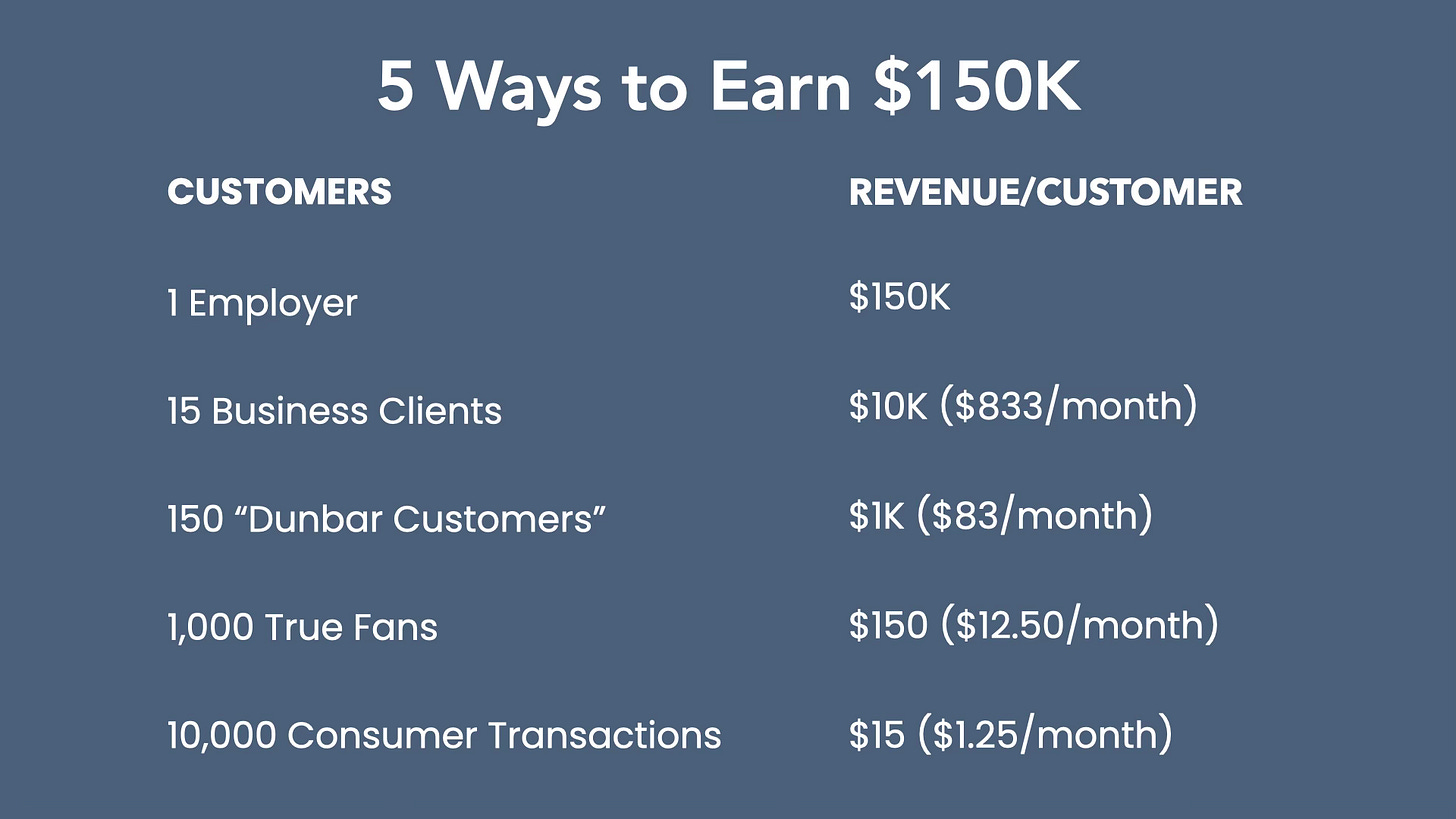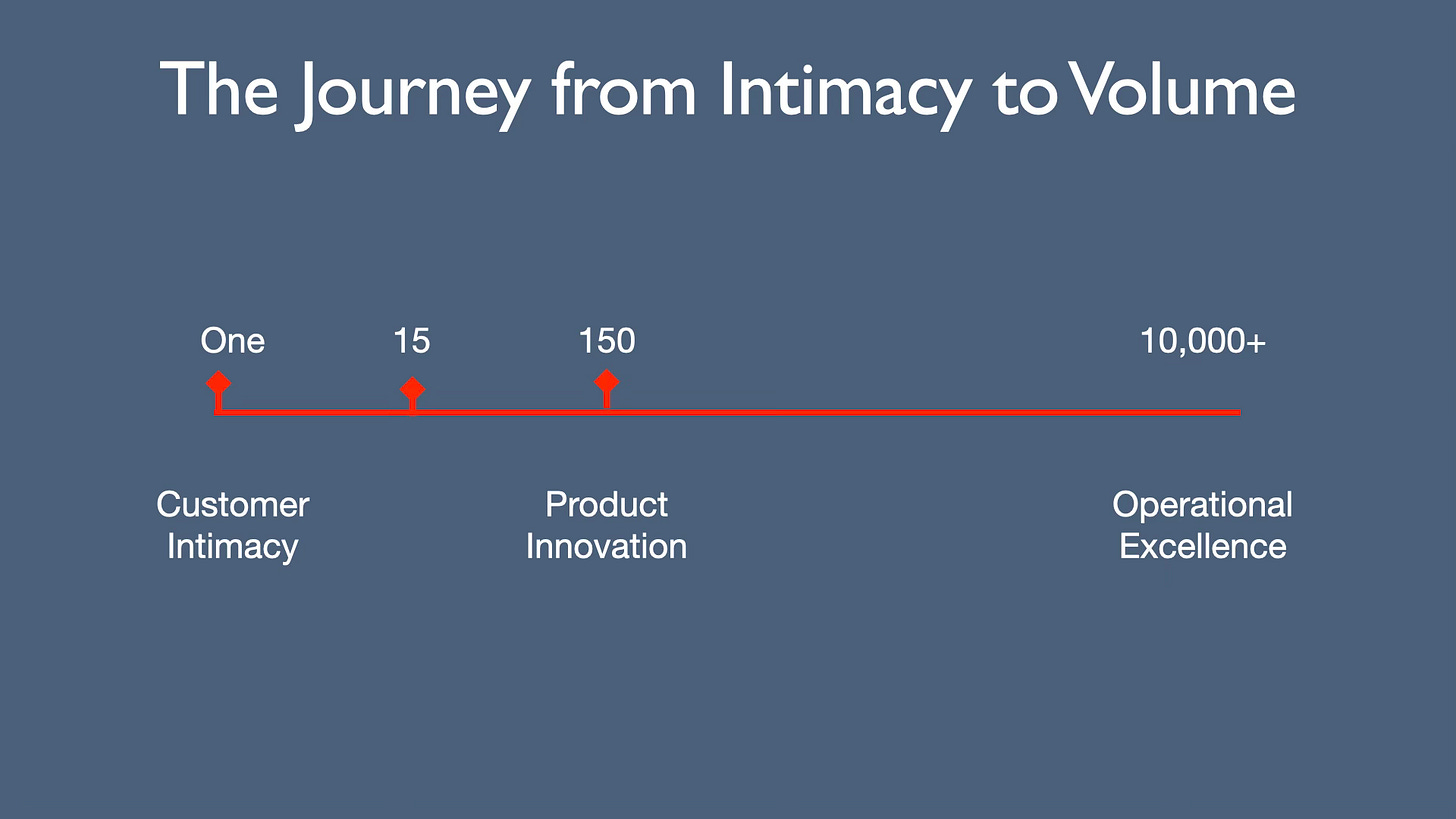Be Serious: How Many Customers Do You Really Want?
How to design a business model that works for you.
What if you designed your business backwards with the end in mind? I believe a business is a means to an end, not an end in itself. Why did you decide to build a business in the first place?
Let’s define the “end” as reaching the stage where the business is predictably profitable enough to thrive and support its purpose--as defined by the founder. It may be financial independence, or it may be to make a positive difference in a corner of human endeavour. Even better, it may be both. Most businesses only succeed if they make a meaningful difference for their customers.
The Revenue Management Triangle
There is a consulting framework known as the "Project Management Triangle" which states that for any given project, you can only choose two out of the three key constraints: scope, time, and cost (or price). We can use a similar set of constraints for a business: Revenue, Price and Number of Customers. The same logic applies, you can only choose two, and solve for the third.
Choose your revenue first
Revenue is the most interesting one to start with. We already decided that our end goal is to be “profitable enough” to support our purpose. For illustration, let’s assume we have no costs and use revenue as a surrogate for profit.
Let’s also assume that you’ve started a business to fund autonomy. Starting with revenue makes sense because it determines your income if you don’t want to sell the business. It also determines your valuation, if and when you want to exit.
Then choose how many customers you want
Once you’ve decided how much revenue you want, you have only one choice left: how many customers you want or the price they pay(strictly speaking spend/customer).
It makes more sense to choose how many customers you want because it will determine the nature of your business in two ways: First, it defines what your personal experience of running the business will be like. Second, it defines your value discipline. The combination defines the most important components of your business model: segmentation, revenue model, and unit economics.
Let’s unpack this by looking at an example. Let’s say you want to make $150k a year, which puts you in the top 5% of earners in the US, and even further in most other countries. You then have a menu of business models depending on how many customers you want--each with their own trade-offs. Let’s look at these by orders of magnitude.
One Customer who is willing to pay you $150K a year. You may recognise this as a “job.” But a job is just another business model--one that provides less autonomy than the other ones, as well as the least antifragility. You lose that customer, you lose 100% of your income.
15 Customers who pay you $10K/year or $833/month. You are a consultant or a freelancer. This is what I’ve been doing for the last twenty years. It provides a fair amount of flexibility, variety and less risk. But it also means more volatility and you are probably still--though not necessarily--selling your time. This model has no economies of scale.
150 Customers who pay you $1K/year or $83/month. Let’s call this a Microniche or Boutique business. But it’s a significant level up. You now have significantly reduced your risk. You have also reached the limit of Dunbar’s number1, theoretically the cognitive limit to the number of customers with whom you can build and maintain stable social relationships. You’ve also probably made a transition from the above models which are likely to be B-to-B to potentially working directly with consumers who value the difference you’re making in their lives. This is the model I’m trying to build with ClimbWorks.
1,000 True Fans who pay you $150/year or $12.50/month. This was covered in Kevin Kelly’s seminal essay2. It’s also become the bread and butter of the ’creator economy’--including Substack. It takes a while to get there, but you still have some relationship with your customers--though it’s an asymmetric one as the term ‘followers’ implies. You are now probably selling a product and seeing increasing economies of scale.
10,000 Customers who pay you $15/year or $1.25 a month. At this level of spending, you probably don’t have recurring customers. Your business is no longer as dependent on customer relationships as it is on transactions. Of course, there is still an opportunity to build more revenue by focusing on relationships and creating recurring customers. But that is probably best done by providing more value, which merits higher price points.
What Value Discipline does your choice imply?
Back in the 90s, Treacy and Wiersema suggested that businesses must focus on one of three value disciplines3:
Customer Intimacy: Building deep, personalized relationships with customers by tailoring their products and services to meet specific customer needs. Extreme examples are a bespoke tailor or furniture maker.
Product Leadership: This discipline is about innovation and product development. Companies that excel in product leadership strive to offer cutting-edge, high-quality products that are highly differentiated.
Operational Excellence: This discipline emphasises efficiency and cost-effectiveness. Companies focusing on operational excellence aim to provide reliable products or services at the lowest possible cost. They streamline processes, minimize waste, and standardize operations.
The framework suggests that while companies should maintain a minimum standard in all three disciplines, they should focus on one to build market leadership and sustainable competitive advantage.
The Natural Progression of Startup Business Models
Even though this framework was developed with startups in mind, it represents the natural progression of business models any founder should follow:
With limited resources, you can start by developing a “concierge” value proposition for a small number of initial customers.
You use the insights on their needs to recognise patterns and innovate a new product which addresses a much larger niche with a high ticket item.
As you gain more experience and scale, you can switch your focus to operational excellence and go for volume, which will also mean lower prices usually.
A journey of 10,000 customers starts with your first one, then your next 15, 150, etc. Each level necessarily favours a coherent combination of price and value discipline. The amount of customers you choose to have determines your business model.
Choose your own adventure
There is no obligation to take this journey all the way to the point where you have a low-price, high-volume business. It’s your choice to decide how far you want to go, given your reasons for deciding to start a business. This is what it means to make your business founder-centric.
Questions, Objections, Complications
You can skip this section if you’re not worried about the details and want to get to the conclusion.
Is this just for lifestyle businesses? What about businesses with headcount?
The approach outlined above still works with multiple founders and employees. Just multiply the target revenue and customer numbers above by your headcount. This will give you averages for each. How evenly you distribute the revenue between founders and employees is up to you and a topic for another day.
Your model only looks at revenue--what about costs?
Great point. I did that deliberately to keep things simple for illustration. But it’s easy to adjust the approach above to reflect the two kinds of costs:
Use gross margin per customer to account for variable costs and your unit economics
Add your overhead costs to your profit target to define a gross margin target that will cover them.
Keep the End in Mind
It's easy to get caught up in chasing more customers and revenue. But take a step back and intentionally design the kind of business you want to build. There's no one "right" number of customers or business model. It all depends on your own definition of success.
"Business is not about money. It's about making dreams come true for others and for yourself." - Derek Sivers
You may be want to become fithy rich and famous by building a unicorn. Or you may aspire to create a smaller, lifestyle business with a tight-knit community of customers. The choice is yours, it’s your business.
Tracy and Wiersema’s original HBR article on Value Disciplines
Join Us!
If you like the sound of this and you want to build a business that harnesses your curiosity, please consider joining us at ClimbWorks, the Unaccelerator for those who want to choose their own adventure.
Why am I launching an Unaccelerator?
Let’s imagine that you’ve decided to start your own business. But you’re not sure how to go about it, and it feels daunting to quit your job and figure out how to do it by yourself. Maybe you’ve got a couple of friends who want to do it with you. But none of you has done this before, and there are significant gaps in your knowledge.






This is great and very timely. I’m working through a similar process for my own business right now.
Also, Ash Maurya has a similar model that I think you might like. Builds on top of the Tomas Tunguz model of rabbit and deer etc. do you know what I’m referring to?